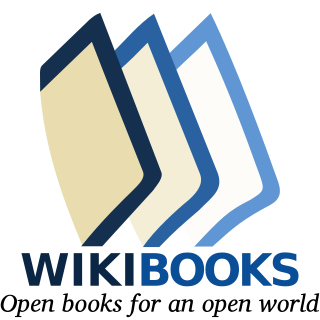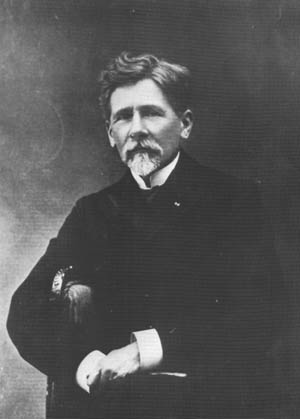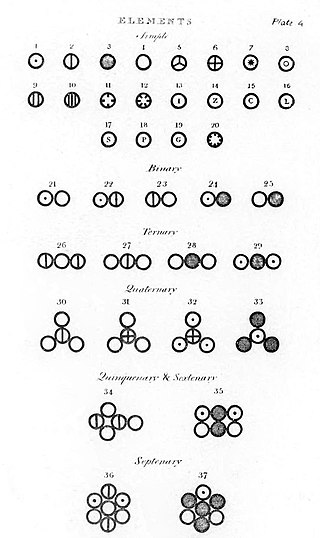This article contains information about the literary events and publications of 1610.

Food science is the basic science and applied science of food; its scope starts at overlap with agricultural science and nutritional science and leads through the scientific aspects of food safety and food processing, informing the development of food technology.

A textbook is a book containing a comprehensive compilation of content in a branch of study with the intention of explaining it. Textbooks are produced to meet the needs of educators, usually at educational institutions. Schoolbooks are textbooks and other books used in schools. Today, many textbooks are published in both print and digital formats.

Wikibooks is a wiki-based Wikimedia project hosted by the Wikimedia Foundation for the creation of free content digital textbooks and annotated texts that anyone can edit.
The year 1615 in science and technology involved some significant events.
The year 1610 in science and technology involved some significant events.
Fusel alcohols or fuselol, also sometimes called fusel oils in Europe, are mixtures of several higher alcohols produced as a by-product of alcoholic fermentation. The word Fusel is German for "bad liquor".

Michael Sendivogius was a Polish alchemist, philosopher, and medical doctor. A pioneer of chemistry, he developed ways of purification and creation of various acids, metals and other chemical compounds. He discovered that air is not a single substance and contains a life-giving substance—later called oxygen—170 years before Scheele's discovery of the element. He correctly identified this 'food of life' with the gas given off by heating nitre (saltpetre). This substance, the 'central nitre', had a central position in Sendivogius' schema of the universe.

Thallium (81Tl) has 41 isotopes with atomic masses that range from 176 to 216. 203Tl and 205Tl are the only stable isotopes and 204Tl is the most stable radioisotope with a half-life of 3.78 years. 207Tl, with a half-life of 4.77 minutes, has the longest half-life of naturally occurring Tl radioisotopes. All isotopes of thallium are either radioactive or observationally stable, meaning that they are predicted to be radioactive but no actual decay has been observed.

Simeon Milivoje Lozanić and Simeon "Sima" Lozanić was a Serbian chemist, president of the Serbian Royal Academy, the first rector of the University of Belgrade, minister of foreign affairs, minister of industry and diplomat. At the Grandes écoles and later when it transformed into the University of Belgrade he taught chemistry and electrosynthesis. He has published over 200 scientific papers and professional publications.

Johann Daniel Mylius was a composer for the lute, and writer on alchemy. Born at Wetter in present-day Hesse, Germany, he went on to study theology and medicine at the University of Marburg. He was the brother-in-law and pupil of Johann Hartmann (1568–1613).

William Morrow and Company is an American publishing company founded by William Morrow in 1926. The company was acquired by Scott Foresman in 1967, sold to Hearst Corporation in 1981, and sold to News Corporation in 1999. The company is now an imprint of HarperCollins.

This timeline of chemistry lists important works, discoveries, ideas, inventions, and experiments that significantly changed humanity's understanding of the modern science known as chemistry, defined as the scientific study of the composition of matter and of its interactions.
Jean Beguin (1550–1620) was an iatrochemist noted for his 1610 Tyrocinium Chymicum (Begin Chemistry) (Digital edition), which many consider to be one of the first chemistry textbooks. In the 1615 edition of his textbook, Beguin made the first-ever chemical equation or rudimentary reaction diagrams, showing the results of reactions in which there are two or more reagents. Modern rendering of this famous diagram, detailing the reaction of corrosive sublimate (HgCl2) with sulfide of antimony (Sb2S3), is shown below:
Edgar Bright Wilson Jr. was an American chemist.

Bernard Béguin is a former French rally driver, who won the Tour de Corse in 1987, a round of the World Rally Championship.
Jean Duvernoy was a French medievalist. Born in 1917 in Bourgoin to a Protestant family, he began to study the Waldensians and later Catharism. He edited and translated a great number of sources, including Jacques Fournier's inquisition register, from which the French historian Emmanuel Le Roy Ladurie extracted Montaillou: The Promised Land of Error.

The Darling of Paris is a 1931 French drama film directed by Augusto Genina and starring Jane Marnac, Jean Gabin and Jean-Max. It was one of the first films to portray Gabin in his characteristic 1930s setting of pessimistic working class locations.
Events from the year 1550 in France
Donna M. Huryn is an American medicinal and organic chemist. She received her B.A. (chemistry) from Cornell University, and Ph.D. in organic chemistry from the University of Pennsylvania. She is on the faculty at the University of Pittsburgh’s school of pharmacy, holds an adjunct appointment in the department of chemistry at the University of Pennsylvania, is the principal investigator of the University of Pittsburgh Chemical Diversity Center, and was a visiting fellow in the summer of 2017 at the University of Bologna. She is a fellow of the American Chemical Society, recipient of the ACS Philadelphia Local Section Award, has held a number of elected positions within the American Chemical Society at both the local and national levels, and is 2015 Chair of the Division of Organic Chemistry. Huryn also formed, along with a number of other scientists, the Empowering Women in Organic Chemistry Conferences in 2019. The goal was to empower and bring the research and career of all marginalized individuals in chemistry-related fields to the forefront of the scientific community. Huryn noticed how there was not enough women pursuing and maintaining a career in organic chemistry, and thus founded this organization. The Empowering Women in Organic Chemistry Conferences allowed for women leaders to present their scientific findings and hear the stories of how eminent women in the field of organic chemistry overcame the challenges they faced being female. She is associate editor of ACS Medicinal Chemistry Letters. She in also an editor of the journal Organic Reactions and co-authored the textbook Medicinal Chemistry and the article "Medicinal Chemistry: Where Are All the Women?" which appeared in the ACS Medicinal Chemistry Letters Journal. Huryn’s research focuses on the design and synthesis of small molecules probes and drugs to treat cancer, neurodegenerative and infectious diseases.











